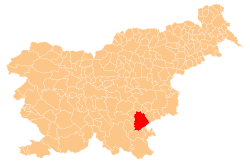Seč, Novo Mesto
Seč (pronounced [ˈseːtʃ]; German: Gehag or Gehack (bei Tschermoschnitz),[1][2] Gottscheerish: Gəhack[3]) is a remote abandoned settlement in the Municipality of Novo Mesto in southern Slovenia. The area is part of the traditional region of Lower Carniola and is now included in the Southeast Slovenia Statistical Region.[4] Its territory is now part of the village of Travni Dol.
Seč | |
|---|---|
 Seč Location in Slovenia | |
| Coordinates: 45°41′38.47″N 15°6′22.03″E | |
| Country | |
| Traditional region | Lower Carniola |
| Statistical region | Southwest Slovenia |
| Municipality | Novo Mesto |
| Elevation | 552.9 m (1,814.0 ft) |
| Population (2002) | |
| • Total | none |
Name
The Slovene name Seč and the German name Gehag, Gehack are semantically identical, referring to cleared land.[5] The Slovene common noun seč means 'logged land, lumbering'[6] as does the German common noun and microtoponym Gehack.[7][8]
History
Seč was a village inhabited by Gottschee Germans. It was founded relatively late because it was not listed in the Gottschee land registry of 1574 or in the 1770 census.[3] In 1931 it had seven houses and a population of 33.[9][10] Before the Second World War the economy of the village was based on farming and selling wood, and the villagers also owned some vineyards.[10] The residents were evicted in 1941 and the village was burned by Italian troops in 1942.[9]
References
- Ferenc, Mitja. 2007. Nekdanji nemški jezikovni otok na kočevskem. Kočevje: Pokrajinski muzej, p. 4.
- Intelligenzblatt zur Laibacher Zeitung, no. 141. 24 November 1849, p. 36.
- Petschauer, Erich. 1980. "Die Gottscheer Siedlungen – Ortsnamenverzeichnis." In Das Jahrhundertbuch der Gottscheer (pp. 181–197). Klagenfurt: Leustik.
- Novo Mesto municipal site
- "Stari in mladi Slovenec." 1870. Učiteljski tovariš 10(8) (15 April): 123–124, p. 124.
- Pleteršnik, Maks. 1894–1895. Slovensko-nemški slovar I–II. Ljubljana: Knezoškofijstvo.
- Hessische Flurnamen. Hessisches Landesamt für geschichtliche Landeskunde. (in German)
- Jung, Irene. 1985. Flurnamen an der mittleren Lahn. Giessen: Schmitz, p. 60.
- Savnik, Roman (1971). Krajevni leksikon Slovenije, vol. 2. Ljubljana: Državna založba Slovenije. p. 529.
- Krajevni leksikon Dravske Banovine. 1937. Ljubljana: Zveza za tujski promet za Slovenijo, p. 471.
